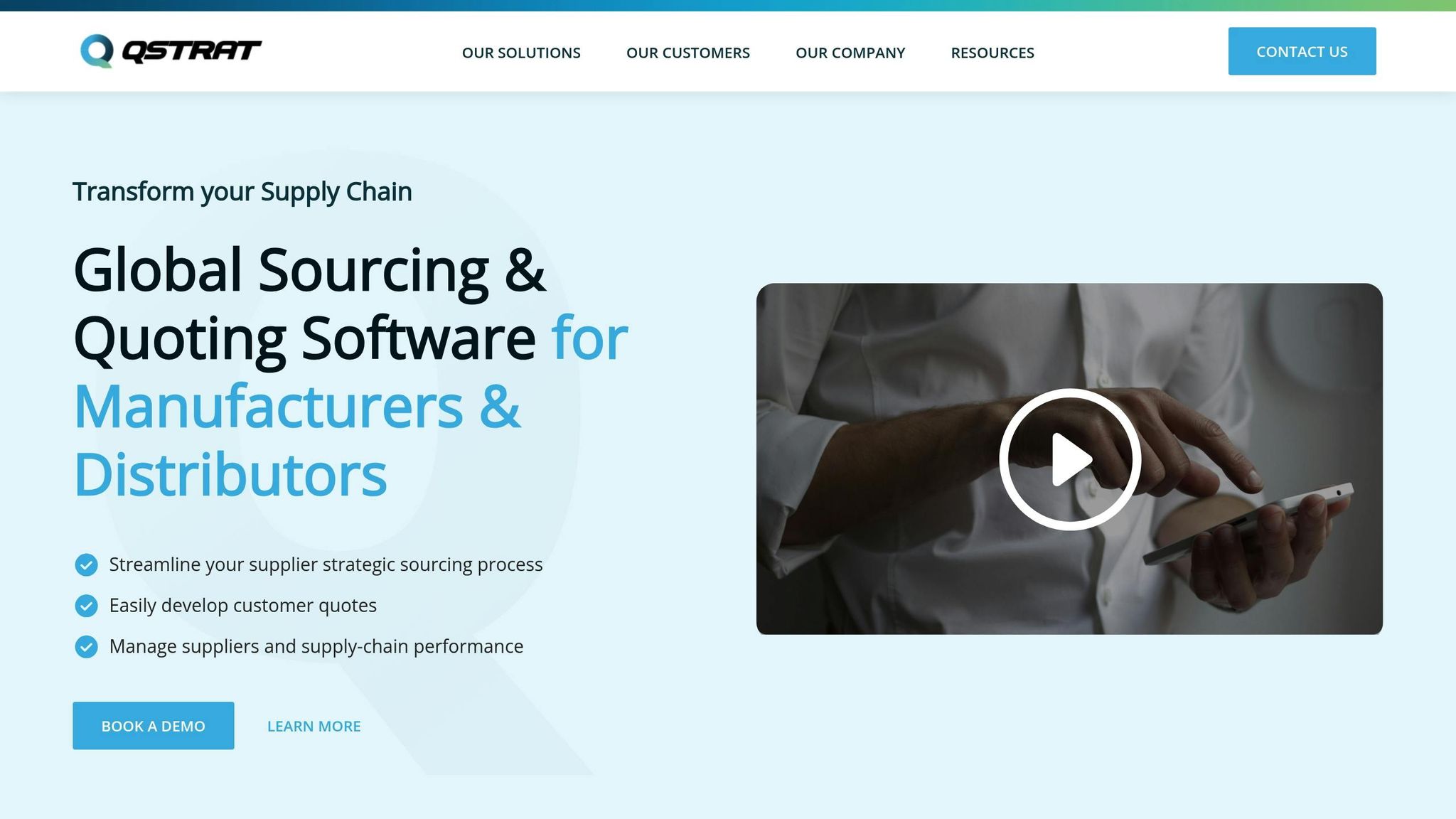Digital Tools for Distributor Relationships: Benefits and Challenges
- October 30, 2025
- 13 Mins Read
- 7 Views

Digital tools are reshaping how manufacturers in the U.S. manage distributor relationships. Traditional methods like emails and spreadsheets often lead to inefficiencies and data silos. Modern platforms, such as cloud-based systems and supplier relationship management (SRM) software, centralize data, enable real-time communication, and automate workflows. This transformation helps businesses improve efficiency, reduce costs, and meet regulatory requirements. However, challenges like system integration, user resistance, and upfront costs require careful planning.
Key Takeaways:
- Centralized Data: Simplifies decision-making and eliminates silos.
- Improved Communication: Real-time messaging and shared dashboards enhance collaboration.
- Automation: Reduces manual errors and speeds up processes.
- Compliance Support: Tracks regulatory requirements and minimizes risks.
- Analytics: Provides actionable insights for growth.
Challenges:
- System Integration: Compatibility with legacy systems can be tricky.
- User Resistance: Employees may hesitate to adopt new tools.
- Data Quality: Inconsistent data undermines effectiveness.
- Costs: Initial setup and ongoing expenses can strain budgets.
The shift to digital tools is no longer optional for manufacturers aiming to stay competitive. By addressing these challenges and following best practices, businesses can streamline operations, strengthen distributor relationships, and improve long-term performance.
Top 5 Benefits Of Using A Supplier Relationship Management (SRM) Software
Benefits of Digital Tools for Distributor Relationships
Digital tools are reshaping how U.S. manufacturers handle their distributor networks, offering measurable gains in efficiency, cost savings, and overall business growth. These tools tackle long-standing challenges in traditional distributor management and pave the way for smarter operations.
Centralized Data Access and Management
One of the standout advantages of digital platforms is their ability to consolidate data. By pulling information from systems like ERP, CRM, and procurement tools into a single, accessible hub, they eliminate the silos that often hinder traditional methods. This centralization enables real-time dashboards that simplify decision-making processes.
The impact of having "one version of the truth" is hard to overstate. In fact, 76% of CFOs agree that lacking a unified data source makes it difficult for organizations to achieve their goals. For manufacturers managing distributors across multiple states or regions, centralized data ensures faster, more informed decisions and the ability to adapt quickly to market shifts. Additionally, these platforms significantly improve communication between manufacturers and their distributors.
Better Communication and Collaboration
Digital tools enhance communication by enabling real-time messaging and shared dashboards. These features ensure quick alignment on orders, inventory, and performance expectations, fostering transparency and trust between manufacturers and distributors.
For example, the Strategic Sourcing team at Carl Zeiss uses QSTRAT Sourcing to streamline interactions with suppliers during New Product Development and Engineering Change processes. Modern platforms also simplify two-way communication through system-generated emails that include essential documents, eliminating the need for separate portals or manual data entry. This seamless exchange of information strengthens collaboration and builds stronger business relationships.
Automated Processes for Efficiency and Cost Reduction
Automation is another game-changer, especially when it comes to repetitive tasks like quoting, sourcing, order processing, and supplier performance tracking. By automating these workflows, manufacturers can reduce manual errors, speed up responses, and cut administrative costs across their distributor networks.
Take BAE Systems, for example – they use QSTRAT Sourcing to compare costs and support quality initiatives, showcasing how automation minimizes errors and shortens cycle times. Automated workflows also streamline requisition and approval processes, ensuring faster quote generation, quicker approvals, and improved responsiveness to customer needs. These efficiencies not only enhance customer satisfaction but also reduce risks and improve compliance.
Risk Management and Compliance Tracking
Digital tools help manufacturers stay on top of supplier performance, contract compliance, and regulatory requirements by triggering automated alerts for non-compliance. They centralize documentation for audits and ensure adherence to U.S. standards like FDA, OSHA, or import/export regulations. This approach minimizes the risk of regulatory violations and supports transparent processes that can withstand both internal and external scrutiny.
Additionally, automated ranking and ESG tools utilize performance data to refine supplier selection and ongoing management. This data-driven strategy ensures consistent quality standards across distributor networks and helps identify potential issues before they disrupt operations.
Data Analysis for Business Growth
Analytics take distributor data and turn it into actionable insights on sales trends, performance, and market opportunities. By aggregating data from various sources, digital platforms make it easier to uncover patterns and opportunities that would be challenging to identify manually.
For instance, one QSTRAT client combined the platform’s tools with their existing MFG/PRO and Cyberquery systems to improve quoting accuracy, track successes, and compare projected versus actual costs. Features like benchmarking, category reviews, and AI-driven alerts for out-of-range quotes help reduce material costs. Enhanced visibility also addresses a common challenge – 65% of procurement leaders report limited insight beyond their tier-1 suppliers. By bridging this gap, manufacturers can detect hidden demand, spot new opportunities, and make strategic decisions that fuel growth.
Altogether, these benefits illustrate how digital tools are driving a transformational shift in managing distributor networks. They empower manufacturers with the tools needed to operate smarter, faster, and more effectively in a competitive market.
Common Implementation Challenges
Implementing digital tools comes with its fair share of challenges for U.S. manufacturers. These include issues like integrating with existing systems, overcoming resistance from users, managing fragmented data, meeting security and compliance requirements, and handling costs. Tackling these obstacles early on can help manufacturers craft better strategies and set realistic expectations, ensuring they reap the full benefits of digital distributor management.
System Integration Difficulties
One of the biggest hurdles is integrating new digital tools with older, legacy systems. Many manufacturers still rely on outdated ERP, CRM, and financial platforms that weren’t built to work with modern technology. This often results in compatibility issues that can derail timelines and inflate costs. Additionally, legacy systems often use different data formats, making it harder to unify processes. When systems don’t communicate seamlessly, teams may turn to manual workarounds, which defeats the purpose of automation.
For example, a company that integrated QSTRAT with its MFG/PRO and Cyberquery systems successfully aligned quoting and cost measurements. However, many such projects encounter delays and budget overruns, especially when dealing with older systems that lack modern APIs or standardized data formats. And technology alone isn’t the only challenge – human factors play a significant role too.
User Resistance and Change Management
Even the most advanced tools can fail if people don’t use them. Resistance from employees and distributor partners often stems from a preference for familiar workflows or concerns about increased workloads. Without proper engagement, these concerns can slow or even derail implementation efforts.
To ensure success, it’s essential to involve key stakeholders early, clearly communicate the benefits of the new tools, and provide tailored training for different user groups. Strong change management practices can make the transition smoother, encouraging quicker adoption and reducing pushback.
Data Quality and Consistency Problems
Digital tools are only as good as the data they rely on, and poor data quality can undermine their effectiveness. Manufacturers often struggle with fragmented supplier and distributor information scattered across multiple systems. This results in incomplete, outdated, or conflicting records, making it difficult to generate accurate reports or dashboards.
Data fragmentation not only hampers visibility and decision-making but also complicates compliance and audits. When information is spread across various sources, demonstrating regulatory adherence or providing accurate documentation during audits becomes a major challenge.
Security and Compliance Requirements
Managing sensitive business and personal data requires robust security measures. Digital platforms must include features like end-to-end encryption, multi-factor authentication, and role-based access controls to keep data secure. They also need to provide detailed audit trails and comply with U.S. regulations such as the California Consumer Privacy Act (CCPA).
As regulations continue to evolve, digital tools must be adaptable to new requirements. This is especially important in highly regulated sectors like aerospace, medical devices, and automotive. Ensuring compliance and maintaining proper documentation for audits are critical to avoiding penalties and safeguarding trust.
Initial Investment and Ongoing Costs
Cost is another significant barrier. Beyond the initial expense of purchasing software, companies face costs for integration, training, data migration, and ongoing maintenance. For instance, upfront costs often include licensing fees and the expenses of connecting new tools to existing systems. Data migration, particularly when cleaning and standardizing information from various sources, can be a time-consuming and costly process.
Then there are recurring expenses, such as software updates, cybersecurity measures, technical support, and continued training. These ongoing costs can strain budgets, particularly for small and mid-sized manufacturers with limited IT resources. Unexpected challenges, like integration delays or resistance to change, can further drive up costs, forcing companies to scale back functionality or extend timelines to manage expenses.
sbb-itb-827f251
Best Practices for Successful Implementation
Rolling out digital tools for distributor management isn’t just about adopting new technology – it’s about doing so in a way that minimizes risks, encourages user adoption, and maximizes return on investment (ROI). A strategic approach makes all the difference.
Define Clear Goals and Performance Metrics
Start with a clear vision of what success looks like. Set measurable KPIs like reducing order processing time or increasing distributor satisfaction. These benchmarks ensure everyone is on the same page and help track progress along the way.
When setting goals, focus on areas such as streamlining sourcing strategies, improving customer quoting processes, and optimizing supply chain performance. Metrics to monitor might include the speed of system implementation, efficiency during RFQs, and accuracy in comparing projected versus actual costs. Goals should also aim to cut costs – for example, by using AI to flag out-of-range quotes or benchmarking material prices. On top of that, improving quote speed, accuracy, and completeness can lead to more business wins. Data quality is another critical area to address. Metrics like the number of supplier data elements collected can significantly impact decision-making. In fact, 76% of CFOs say that without a unified source of truth, meeting business goals becomes a challenge.
Gradual System Integration Approach
Once goals are set, a phased approach to integration can help ensure a smoother rollout. Breaking the implementation into smaller, manageable steps reduces disruptions and allows for early issue detection. For example, you might start with a pilot program in a specific department or region. Feedback from these initial phases can help refine processes before broader deployment, minimizing risks while keeping operations running smoothly.
Take a manufacturer as an example: they could begin by integrating digital quoting tools with their CRM system. Once that’s running smoothly, they could expand to include ERP and supplier management systems. While this phased approach may take more time overall, it reduces the likelihood of major setbacks and ensures a more seamless transition.
Employee Training and Support Programs
Even the best tools can fall flat without proper training. Hands-on workshops, e-learning modules, and accessible support resources are key to overcoming resistance and ensuring employees feel confident using new systems. Getting employees involved early, offering clear documentation, and setting up help desks or peer support networks can make the transition smoother.
Continuous learning opportunities also play a big role in keeping teams engaged. Recognizing early adopters and involving leadership in the process can further encourage widespread acceptance. These steps not only ease the adoption process but also help embed the new tools into everyday workflows, improving distributor interactions along the way.
Strong Data Management Practices
Digital tools rely on accurate data, making strong data management practices a must. Regular audits, standardized data entry protocols, and clear governance policies ensure data remains clean, consistent, and secure. For example, automated tools can merge duplicate records, creating a unified and reliable data source.
Take Carl Zeiss as a case in point: their Strategic Sourcing team uses digital tools to collect over 50 data elements from suppliers. This comprehensive approach ensures better decision-making and highlights the importance of robust data management.
Cloud-Based Platforms like QSTRAT

Cloud-based platforms bring a lot to the table by centralizing data, automating workflows, and integrating seamlessly with existing systems. QSTRAT, for instance, offers a global sourcing and quoting solution tailored for manufacturers and distributors. It simplifies supplier sourcing, automates quoting, and manages supplier performance – all while integrating with CRM, ERP, and other systems.
Industries with complex needs – like aerospace, medical devices, and automotive – can particularly benefit from QSTRAT’s scalability, remote access, and regular updates. Speed is another key advantage. One customer reported going live with QSTRAT Sourcing in just five days, which allowed for a quick transition to more efficient RFQ processes. For BAE, the platform has also served as a learning tool for suppliers, ultimately driving quality improvements and better manufacturing outcomes.
Conclusion: Digital Transformation of Distributor Relationships
The digital shift in distributor management is reshaping U.S. manufacturing, offering a more efficient way to operate while significantly cutting costs. Companies embracing this transformation are reaping measurable benefits, from smoother workflows to noticeable financial improvements.
Take, for example, an industrial manufacturer that managed to cut quote turnaround times by 40% and save over $500,000 annually through digital tools. Automation is eliminating redundant tasks and reducing errors, while real-time analytics are helping businesses identify market opportunities and respond quickly to changing demands. With 76% of CFOs acknowledging the challenge of meeting business goals without a centralized, reliable source of supplier data, the importance of digital platforms becomes crystal clear.
However, the journey to digital success isn’t without its challenges. Companies must address hurdles like system integration, user resistance, and the need for investments in infrastructure and training. Cloud-based platforms such as QSTRAT illustrate how the right technology can simplify even the most complex processes, enabling faster responses to customer needs while maintaining high standards for data accuracy and compliance.
For U.S. manufacturers, adopting digital tools with clear objectives and proven strategies is no longer optional – it’s essential. By sticking to best practices, businesses can unlock greater efficiency, reduce costs, and ensure sustainable growth in today’s competitive landscape.
FAQs
What are the main advantages of using digital tools to manage distributor relationships in manufacturing?
Digital tools offer powerful benefits for managing distributor relationships in the manufacturing world. They simplify tasks like sourcing suppliers, automating quotes, and tracking supplier performance. The result? Smoother communication, lower operating costs, and more chances to win new business.
By connecting systems like CRM, ERP, costing, and sourcing, these tools create a unified workflow. This eliminates inefficiencies and keeps all critical data in one central location. The streamlined setup not only makes complex operations easier to handle but also boosts decision-making and strengthens distributor relationships.
What are the best ways for manufacturers to address system integration issues and user resistance when adopting digital tools?
To overcome challenges with system integration and user resistance, manufacturers should prioritize digital solutions that streamline operations and make adoption easier. Tools like QSTRAT bring together essential functions – such as CRM, ERP, costing, quoting, and sourcing – into one unified platform. This approach minimizes complexity and ensures a smoother fit within existing workflows.
When it comes to user resistance, the key lies in offering clear training, consistent support, and open communication about the advantages of the new system. Emphasizing how automation cuts down on manual tasks, boosts efficiency, and promotes better collaboration can help users feel more confident and engaged, paving the way for a smoother transition.
What are the best practices for manufacturers to successfully implement and adopt digital tools for managing distributor relationships?
To make the most of digital tools for managing distributor relationships, manufacturers should aim to simplify how they source suppliers and automate repetitive tasks. By integrating systems like CRM, ERP, and costing tools, they can improve communication and ensure data flows smoothly between teams.
Clear communication with stakeholders is key. Automating processes like requisitions, notifications, and approval workflows helps cut down on delays and keeps operations running efficiently. On top of that, offering proper training and ongoing support for team members ensures these tools are adopted effectively and deliver their full potential.



